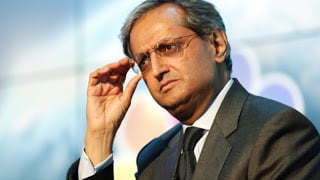(Reproduced version below: Complete credits to Economic Times: http://articles.economictimes.indiatimes.com/2012-10-26/news/34750114_1_chief-risk-officer-investment-bank-michael-e-o-neill )
Vikram Pandit given three choices : Resign now, resign end of year or be fired!
A stunned Pandit chose to resign immediately. Even though Pandit and the board have publicly characterized his exit as his decision, interviews with people close to the board describe how the chairman maneuvered behind the scenes for months ahead of that day to force Pandit out and replace him with Michael L Corbat, the board’s chosen successor. Once he became chairman this year, O’Neil, 66, meticulously built a case for the chief executive’s ouster, they say, first meeting privately with less-satisfied board members and then drawing in others until Pandit had virtually no allies left.
As Pandit was reeling from his encounter, three board members confronted John Havens, the bank’s chief operating officer and a longtime lieutenant.
“Vikram has offered his resignation, and we would like to give you the opportunity to offer yours,” a board member said, following a script prepared by the board’s lawyers, according to several people with knowledge of the meeting.
Startled, Havens briefly challenged the directors, pointing to the solid performance of the institutional clients group, and then relented, saying his resignation would be on Pandit’s desk within five minutes.
The dramatic boardroom coup at the bank’s Park Avenue headquarters has rankled some people at Citi, especially senior executives who feel that the action was needlessly ruthless and who spoke only on the condition that they not be identified. They point out that Pandit successfully steered the once moribund bank through one of its most turbulent chapters, repaid roughly $45 billion in federal lifelines, rebuilt capital and began to focus the sprawling institution.
This week, senior executives at the investment bank convened a group of employees to try to stem any exodus, according to several people briefed on the meeting. Among the employees’ questions: why remain at a bank that treated its top executive so harshly?
Now, the new top officials of the bank are circling to retain the support of some crucial executives, including Brian Leach, Citi’s chief risk officer and a longtime ally of Pandit, and James A. Forese, who heads the securities and banking division, according to several people close to the discussions.
Pandit, O’Neill, Havens and Corbat did not return calls for comment or declined to comment.
The seeds of the turmoil were planted in April when O’Neill, who had been on the board since 2009, took over as chairman from Richard D. Parsons.
Beneath the gaiety, though, tensions between Pandit and O’Neill were already building, some executives said. The dinner came roughly a month after the Federal Reserve dealt an embarrassing setback to Citi by rejecting its proposal to buy back shares and increase its dividend to shareholders. O’Neill used that March misstep to persuade some board members that a better relationship with regulators could have avoided the public failure. Some board members felt, according to people close to the bank, that the Federal Reserve had needed to reject the capital plans of one bank to lend credibility to its stress tests. A handful blamed Pandit for allowing Citi to become that bank.
Compared with Parsons, O’Neill took an unusually active managerial role at Citigroup, visiting trading floors and asking detailed questions about some of the business lines. This involvement at times agitated Pandit, according to the people briefed on the matter.
As summer came, O’Neill continued to make his case, raising concerns about Pandit’s grasp of certain business issues to a handful of board members he considered sympathetic, including William Thompson, the former chief executive of Pacific Investment Management, according to several people close to the bank. Thompson didn’t return calls for comment, nor did other members of the board.
O’Neill continued to build his case for a leadership change in individual meetings, according to several people familiar with the discussions. He chose to meet with the board members most loyal to Pandit last. In some of these discussions, he told the board members that the decision to replace Pandit was already backed by a majority of the 12-person board, according to people familiar with the discussions.
As to a successor, O’Neill had grown comfortable with Corbat well before he became chairman. Corbat headed Citi Holdings, the unit that holds the bank’s soured assets, and O’Neill was the board member overseeing relationships with federal regulators for the unit. As such, the two made trips to Washington together, according to senior bank executives.
In fact, the boardroom coup that landed Corbat at the top really stung Havens because he had long been a champion of Corbat, according to several people close to the bank.
Exactly when the board settled on a successor is unclear. But a few weeks before confronting Pandit, O’Neill called Corbat in London to tell him there was a possibility he might be called upon in the near term to become the chief executive.
Discussions among the board members accelerated while Pandit was in Japan at the annual meeting of the International Monetary Fund and the World Bank. When Pandit returned to New York to prepare for the quarterly earnings call, he had no inkling of what was awaiting him, people close to him said.
Meanwhile, O’Neill was putting the final touches on his plan, according to people familiar with those discussions. Saying Pandit would very likely be resigning soon, he summoned Corbat from London back to New York to take the mantle.



































